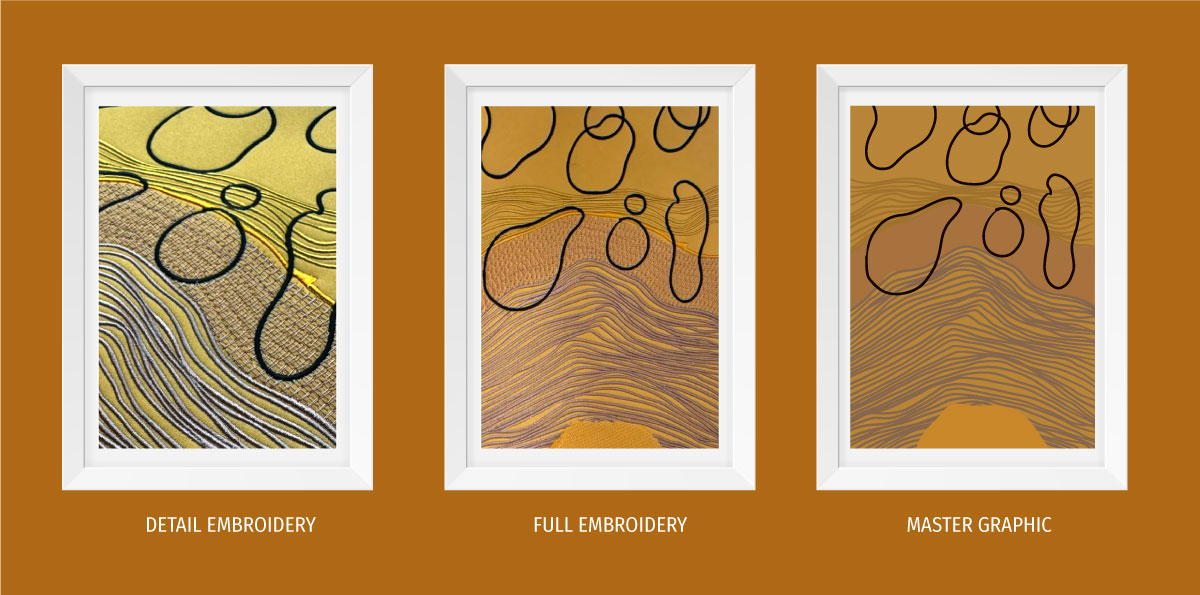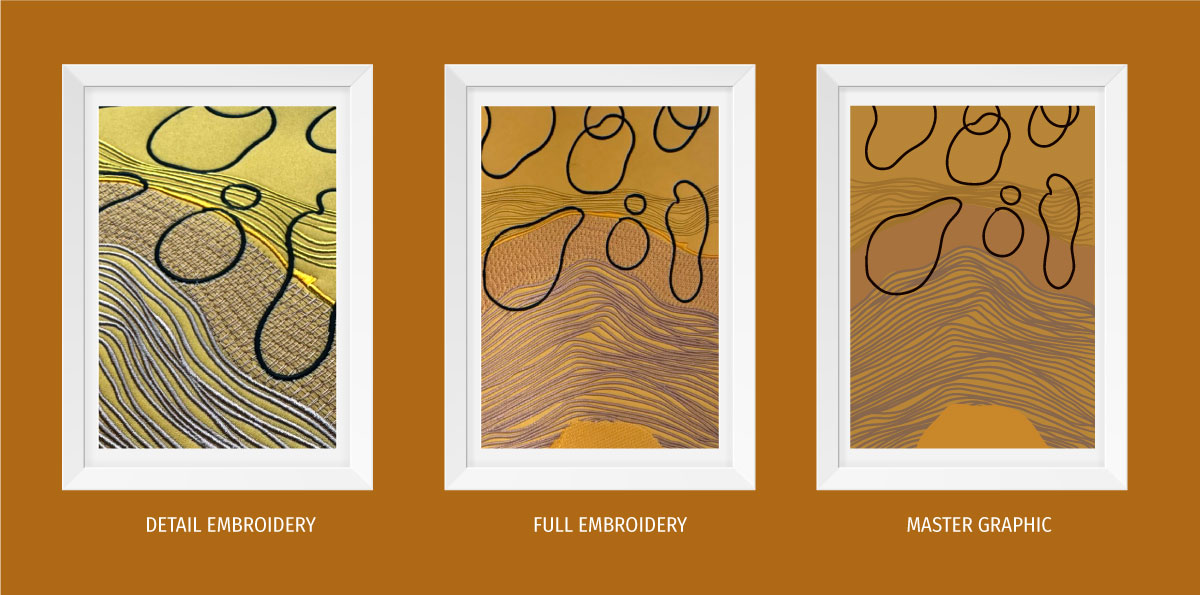
Ms. Nalinee Netithammakorn

Abstract :
The objective of this study is to investigate and design embroidery patterns using colour obtained from peroxidase-catalysed coloration. In the creative process, there is an exploration of natural elements and environments related to the earth element, which is one of fundamental elements of science. The earth element reflects various natural elements such as mountains, trees, leaves, and rocks. This understanding of beauty and uniqueness is translated into shapes and forms and design aesthetic. Subsequently, conceptual images or lines that represent the design concept are sketched in line patterns. These draft designs are then used to create embroidery patterns in pattern design software, with colours reflecting the mystery and beauty of the earth element. Brown colour is used to express design aesthetic with different shades and hues which are colour obtained from peroxidase-catalysed coloration on different fibre-based embroidery yarns. Evaluation of the results of pattern creation and colour tones is conducted to assess an alignment with the design concept and inspiration, followed by adjustments and modifications to reach the desired design. The outcome of this study and design process is embroidered patterns that are indicated to nature. This approach may evoke feelings of tranquility and completeness in the artwork. The selected colour tones associated with the earth element create a sense of density and depth, making the patterns appear clear and balanced in computerised embroidery pieces.
Objectives :
To study and design textile patten inspired by the earth element and express in terms of design aesthetic using colour obtained from peroxidase-catalysed coloration.
Conceptual Framework :
The study and design of embroidery patterns inspired by the earth element may include the following tasks;
1. Inspiration research: Analysing and explaining the inspiration from the earth element, which may come from a fascinating fundamental of science, local wisdom, cultural traditions, or natural characteristics of the relevant area.
2. Theoretical study: Gathering and studying literature related to the use of the earth element-inspired in arts and design.
3. Analysis of Characteristics and Patterns: Analysing the characteristics and patterns created from the earth element inspiration to understand the relationship and connection with nature and the environment.
4. Embroidery pattern design: Utilising embroidery pattern design software to create prototype or template designs that can be used with computerised embroidery machines. Designers analyse the characteristics and patterns created from the earth element inspiration to understand their relationship and connection of nature and the environment for expressing in design aesthetic.
5. Colour tone selection: Selecting colour including shades and hues of colour obtained from peroxidase-catalysed coloration (Netithammakorn et al, 2020) that can be represented the characteristic of the earth element and nature to add depth and aesthetic to the patterns.
6. Societal and environmental impact analysis: Analysing the impact of embroidery patterns designed with the earth element-inspired colour tones on society and the environment, including considering the importance of promoting environmental conservation and protection.
Process / Methodology :
The process of studying and designing embroidered patterns with colour with different shades and hues inspired by the earth element consists of the following steps;
1. The earth element inspiration study: Researching and analysing the inspiration from the earth element, which may come from the natural characteristics of the earth element including trees, leaves, or rocks and the surrounding environment, as well as collecting data and surveying the natural characteristics of the earth element.
2. The earth element nature survey: Conducting surveys of local the earth element nature, collecting data on the earth element characteristics, and related environmental factors.
3. Analysis and description of the earth element characteristics: Analysing the earth element characteristics obtained from data and surveys to understand the specific features and important properties of the earth element.
4. Selection of the earth element-related colour: Selecting colour including shades and hues of colour obtained from peroxidase-catalysed coloration (Netithammakorn et al, 2020) that can reflect the characteristics and features of the earth element, particularly the intensity of colours and the balance between colour.
5. Embroidery pattern design: Designing embroidery patterns with colour tones related to the earth element, using the data from studies and surveys to create meaningful and comprehensive patterns that reflect the essence of the earth element.
6. Embroidery and material usage: Employing embroidery techniques and suitable materials to create patterns that align with the inspiration from the earth element.
7. Evaluation and revision: Evaluating the results of designing embroidered patterns with earth-inspired colour tones and adjusting may require as needed.
Techniques and Materials :
Embroidery computer digitiser, using pattern drafting software and digital embroidery machines, transforms patterns into digital files that instruct the machine to create patterns automatically (Dreams, 2021). Computerised embroidery digitising is a technique similar to computerised pattern embroidery, known as machine embroidery, which typically refers to using embroidery machines for home use. This system can embroider complex patterns quickly and accurately.
Result / Conclusion :
The study of designing embroidered patterns inspired by the earth element using colour obtained from peroxidase-catalysed coloration provided desired patterns that represent the earth element inspiration, yielding interesting and beautiful outcomes. This embroidered pattern enhances the design aesthetic of the products appearance. The selected colour including shades and hues reflects the balance and diversity of the earth element in the designed area. Presenting these results can enhance understanding and appreciation of the importance of the earth element and nature.
The submitted work represents detail of embroidery (left) full embroidery (center) and master graphic of embroidery work (right) which was created from computerised embroidery digitizing using different types of yarn such as cotton, polyester, viscose fibres. The colour used was generated from peroxidase-catalysed coloration using a precursor 2-aminophenol in the presence of hydrogen peroxide in the controlled condition and pH values at 30°C. Embroidery yarn in black colour was also applied on the work to add more initial characteristic to the work.
Designing colour-toned embroidered patterns inspired by the earth element is a process where carefully planned in the design process leading to beautiful and impressive results. Using the earth element as an inspiration of the design idea helps designer establish a deeper understanding and connection with nature, creating a profound sense of completeness and depth in the work. The designed pieces exhibit a balance and beauty that reflect the vitality of the earth element and nature. It also provides a recommendation to incorporate an understanding of nature conservation into artistic endeavors, leading meaningful work.
References :
Deer, J. (2019). “What is Embroidery Digitizing? How to Easily Get Started.” from https://www.digitizingmadeeasy.com/.
Dreams, D.U. (2021). “Digitized Embroidery – Complete Guide to Techniques Involved.” from https://www.cre8iveskill.com/.
Netithammakorn, N., Smith, E., Lerpiniere, C. and Shen, J. (2020). Peroxidase-catalysed coloration of wool fabrics. Coloration Technology, 137(2), p. 93-107. DOI:10.1111/cote.12510